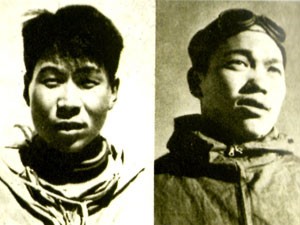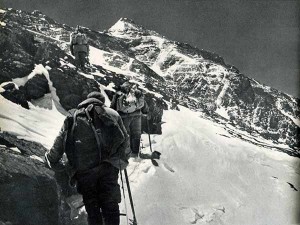There has been a lot of gushing editorial written recently to commemorate the 50th anniversary of the first American ascent of Everest in 1963. Rightly so, as it was a very successful expedition, thanks chiefly to the determination of two men, Tom Hornbein and Willi Unsoeld, who slipped up the West Ridge, a route which even today has rarely been climbed, then did a full traverse down the mountain’s “normal” route, the Southeast Ridge, rescuing two of their teammates on the way, Barry Bishop and Lute Jerstad who had also reached the summit that day but were struggling to descend. The expedition had been concentrating its resources on ascending by the normal route and three weeks earlier Jim Whittaker had become the first American to climb Everest, when he reached the top with Nawang Gombu Sherpa. Hornbein’s and Unsoeld’s ascent by a new route had been a sideshow to the main event, but it was a much greater achievement in mountaineering terms.

I could write a bit more about the expedition here, but I wouldn’t be adding anything to what’s already out there. Instead I’m going to talk about another expedition which took place on Everest’s north side three years earlier. One of the posts I read last week, 50 things about the 50th anniversary of the 1963 American Everest Expedition, lists many fascinating facts, like there were 909 porters, 10 tons of food packed into 416 boxes, the team members had 15 wives and 26 children between them and five had PhDs. As I was slowly drifting into a deep sleep one of the statistics caught my attention and made me sit upright in my chair, as I’m sure many of you have done in meetings.
“Only six people had ever stood on the summit before the American expedition — Edmund Hillary and Tenzing Norgay in 1953 and four Swiss climbers in 1956, Ernst Schmied, Juerg Marmet, Dolf Reist and Hans-Rudolf von Gunten.”
It caught my attention because it almost certainly isn’t true. Most official lists of Everest summiteers state that three climbers, Wang Fu-chou and Chu Yin-hua from the People’s Republic of China, and a Tibetan called variously Konbu or Gonpa (or perhaps Gombu), reached the summit from the north side in 1960. So why did the article state only six climbers reached the summit before the Americans? Did they mean only six climbers had reached the summit from the south side, or are they making a conscious decision to erase the Chinese expedition of 1960 from history?
When they announced they had made the first successful ascent of Everest from the north, the Chinese were greeted with scepticism in the West. Many of the incidents described in the report of their ascent seemed unlikely, even a little bizarre.
Here are just some of them:
- The four climbers who set out on summit day were Wang Fu-chou (a geologist), Chu Yin-hua (a lumberjack), Liu Lien-man (a fireman), all loyal members of the Chinese Communist Party, and Konbu (a Tibetan peasant). Most of them had only been climbing for two years.
- They started out from a high camp at 8500m, which puts them firmly on the Northeast Ridge, probably on the slabs just beneath the First Step, although Mushroom Rock between the First and Second Steps is a possible location for a small campsite. Most expeditions these days set out from between 8200m and 8300m, well below the summit ridge where there is much more room for a campsite.
- It took them three hours to climb the Second Step. Liu Lien-man made four attempts to free climb it but kept falling. Chu Yin-hua then took his cramponned boots and thick woollen socks off to have a go, but also fell. They eventually got up when Liu used his expertise as a fireman to lift his teammates using the “short ladder method”. This involved standing on his shoulders as he crouched down to accommodate them. With a great effort he then stood up and enabled them to reach above and haul themselves on top.
- When Liu collapsed from exhaustion 100m beyond the Second Step, the three communists held an emergency meeting. They decided Liu would wait with an oxygen cylinder while the others continued to the summit. In Wang’s words “though he wasn’t with us his noble spirit gave us great strength to score the final victory”.
- It was dark when they reached the summit at 4.20am. By then their oxygen had run out and they completed the final stretch along the summit ridge on all fours with Konbu leading.
- They left a Chinese flag and a small plaster bust of Chairman Mao on the summit, together with a pencilled note containing their signatures under a small heap of stones. None of these items were there when the Americans reached the summit three years later.
- They descended during darkness, picking up Liu on the way. According to Wang they were successful because “it was the shining light of the Party and Chairman Mao Tse-tung who gave us the boundless strength and wisdom”.

The pompous Communist language probably didn’t aid the veracity of their story in the eyes of Western climbers, and there was doubtless some incredulity that the Chinese might succeed with novice climbers where seven earlier expeditions containing the cream of British mountaineering had failed. But despite the curious incidents that took place on summit day, members of the Chinese expedition were very open about their climb, and answered many questions about it in following years. These days their ascent is generally considered to be genuine and appears in official records. Here are some of the reasons why:
- Although they were novices they had followed an extremely rigorous fitness training programme, and their climbing experience included ascents of 6177m Nyenchin Tangla and 7546m Muztag Ata.
- Their statement about reaching the summit in darkness after running out of oxygen was perhaps the claim that seemed most implausible to people at the time. The editor of the Himalayan Journal left a snotty note against it in his published version of the Chinese account which read “it is, perhaps, necessary to point out that we cannot endorse this exÂtraordinary statement”. In 1960 nobody believed Everest could be climbed without oxygen, but many other climbers have done it since.
- Chu Yin-hua’s story about taking his shoes and socks off to climb the Second Step suddenly became more believable to American climbers who went to question him when he took them off again to reveal ten little stumps where his toes had once been.
- Chris Bonington questioned expedition leader Shih Chan-Chun at length and professed himself to be in no doubt about the ascent.
- When they completed the second ascent of Everest from the north in 1975, another Chinese team left a six foot metal tripod there which Doug Scott and Dougal Haston found when they completed the first British ascent four months later.

What convinces me most the Chinese ascent of 1960 must have been genuine was the route description in their official expedition account. While sometimes a little vague about the details it contains enough of them to prove they must have actually been there. [Note my source for this is Peter Gillman’s excellent anthology Everest: Eighty years of triumph and tragedy, which quotes Wang’s account in its entirety.]
- They describe scaling a one-metre rock on the way. Although the Third Step is higher than this in total, it consists of a number of obstacles which could fit this description to an exhausted climber ascending in the dark.
- They describe having to ascend an ice and snow slope in knee-deep snow. Their description matches that of the lower part of the summit pyramid immediately above the Third Step.
- They describe confronting a sheer ice cliff at the top of the slope and having to circle around it in a westward direction. This is exactly the route climbers follow today.
- They describe being overjoyed to reach a false summit, only to discover another peak a few metres higher on the other side. The final part of the summit ridge does indeed undulate in this way, and although the true summit can be seen from some distance away, this description is consistent with climbers approaching the summit in the dark.
We should remember that apart from George Mallory and Sandy Irvine, who may also have reached the summit along this route in 1924 but did not return to tell the tale, nobody had ever been that way before. If Wang and Chu had been making their story up it would have been a remarkable coincidence for them to describe features on the route in sequence without having seen them. They couldn’t have stolen the route description from someone else because it didn’t exist. I climbed the route myself last year, and sketchy as their account is on some of the details, there’s no doubt in my mind they were describing the route to the summit along the Northeast Ridge. They must have reached it.
So, sorry America, great as your 1963 expedition was, you have Everest’s 10th, 12th, 13th, 14th and 15th summiteers, but the Chinese got there first. You can console yourselves that we in Britain had many more expeditions, but we had to wait until Doug Scott, Dougal Haston and Pete Boardman became the 50th, 51st and 52nd summiteers in 1975. As far as I know none of them had PhDs.






Comments are closed.